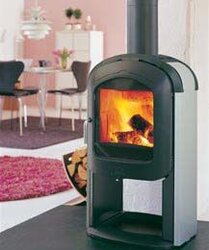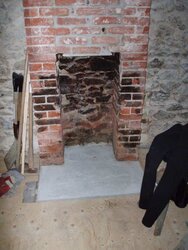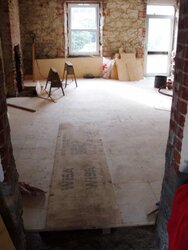Hi I found this site this morning and have got back from work now so can ask a question (be kind I'm new  )
)
Situation:
I live in Guernsey (near France) and am rennovating a granite semi-detached cottage of about 100m2 right by the sea. I worked out my heat loss the other day and it is about 9 kw or 31,000 btu/h. Downstairs is a lounge/corridor/kitchen/loo and upstairs 3 bedrooms and a bathroom. The lounge is 6.5m x 4.7m (x2.4m high). I make this room about 3.85 kw (13,000 btu/h).
Heating:
I'm planning on insulating a bit better and need to plumb everything (originally no internal plumbing). I am not keen to go with oil as it is currrently 46p a litre and rising (reckon I'd need 1000 litres a year for heating and hot water). The outside temperature never freezes and according to some stats I found the mean air temp over winter varies between 6C to 8C. Some days it dips to 1C or so but never below zero, some days it is 12C or so. No snow and rarely frost.
I was planning on putting a wood burning stove in the main room and was thinking of a Vermont Casting Intrepid II or something around 7kw.
I'm asking here if that is a good choice for burning wood as and when I can find it (main heating will be something else - maybe solar store/radiators etc we get 1800 to 2000 hours sunshine a year) - it's hard to get a good supply of wood but I am keen to have a stove nonetheless. Most of the wood is carpentry offcuts and so on.
I'm guessing that this sort of size could really help me out in Jan/Feb when it is colder outside and bump the heat for weekends and evenings.
I have read a bit here on stoves with soapstone sides too - this sounds interesting. The local shop sells VC / Jotul / some italian ceramic shiny red stoves / Hunter / Stovax etc
I rebuilt the chimney from the hearth to the pot and lined it with ceramic/terracota liners. The old fireplace is about 23" wide and 14" deep. I currently have no lintel/mantle so can have any height. I am guessing that I would need to stand the stove into the room as the VC Intrepid is something like 21" and this wouldn't give good heat circulation?
Any advice on this stove and situation would be gratefully accepted
Many thanks
Ed
 )
)Situation:
I live in Guernsey (near France) and am rennovating a granite semi-detached cottage of about 100m2 right by the sea. I worked out my heat loss the other day and it is about 9 kw or 31,000 btu/h. Downstairs is a lounge/corridor/kitchen/loo and upstairs 3 bedrooms and a bathroom. The lounge is 6.5m x 4.7m (x2.4m high). I make this room about 3.85 kw (13,000 btu/h).
Heating:
I'm planning on insulating a bit better and need to plumb everything (originally no internal plumbing). I am not keen to go with oil as it is currrently 46p a litre and rising (reckon I'd need 1000 litres a year for heating and hot water). The outside temperature never freezes and according to some stats I found the mean air temp over winter varies between 6C to 8C. Some days it dips to 1C or so but never below zero, some days it is 12C or so. No snow and rarely frost.
I was planning on putting a wood burning stove in the main room and was thinking of a Vermont Casting Intrepid II or something around 7kw.
I'm asking here if that is a good choice for burning wood as and when I can find it (main heating will be something else - maybe solar store/radiators etc we get 1800 to 2000 hours sunshine a year) - it's hard to get a good supply of wood but I am keen to have a stove nonetheless. Most of the wood is carpentry offcuts and so on.
I'm guessing that this sort of size could really help me out in Jan/Feb when it is colder outside and bump the heat for weekends and evenings.
I have read a bit here on stoves with soapstone sides too - this sounds interesting. The local shop sells VC / Jotul / some italian ceramic shiny red stoves / Hunter / Stovax etc
I rebuilt the chimney from the hearth to the pot and lined it with ceramic/terracota liners. The old fireplace is about 23" wide and 14" deep. I currently have no lintel/mantle so can have any height. I am guessing that I would need to stand the stove into the room as the VC Intrepid is something like 21" and this wouldn't give good heat circulation?
Any advice on this stove and situation would be gratefully accepted

Many thanks
Ed




